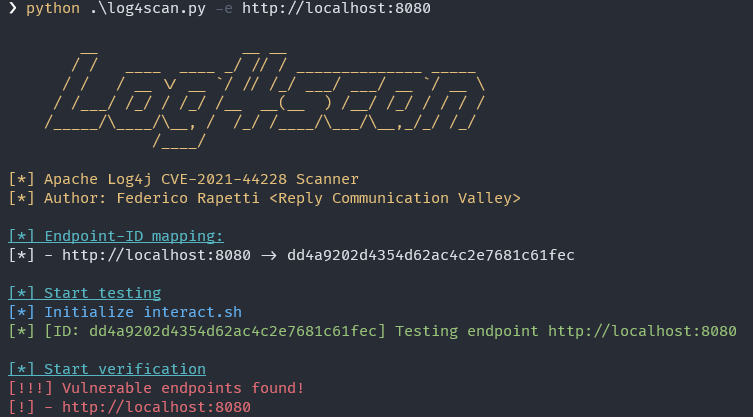omigood (OM I GOOD?)
This repository contains a free scanner to detect VMs vulnerable to one of the "OMIGOD" vulnerabilities discovered by Wiz's threat research team, specifically CVE-2021-38647.
Original blog post from Wiz: https://www.wiz.io/blog/omigod-critical-vulnerabilities-in-omi-azure
Overview
The scanner requires Azure credentials to connect to Azure APIs and, given a subscription and a resource group (or by default it will scan all the available ones), retrieves the list of Linux VMs and reports whether the machine might be vulnerable.
Also make sure to check out Microsoft's own tool for this purpose: https://github.com/microsoft/OMS-Agent-for-Linux/tree/master/tools/OMIcheck
Authentication
To authenticate against Azure APIs, both azure cli (default) and Interactive Browser authentication are supported, check the --auth command line parameter.
Performed checks
There isn't a straightforward way to determine whether your machines are vulnerable to OMI without running commands on the Linux machine itself, which is supported through Azure APIs using the RunShellScript command through an extension. Microsoft's own tool (https://github.com/microsoft/OMS-Agent-for-Linux/tree/master/tools/OMIcheck) uses this approach as well.
It's worth noting that, even if the VM is vulnerable, it might not be exposing the OMI server via HTTP/HTTPS (which is the default) and, even if it does, those ports might be blocked by Azure's Network Security Groups, hence not reachable. This is not a reason to avoid patching but, if you have a lot of vulnerable Linux VMs, it might be useful to know which ones are more exposed and prioritize your efforts.
omigood follows this more comprehensive approach and will produce a JSON output with a number of checks that you can trigger through command line options in order to determine your attack surface.
These are the checks performed by omigood:
- Check against Azure API if the VM is running Linux
- Check against Azure API if the VM is running the OMSAgentForLinux extension, which is a good hint on whether the machine might be running OMI as well.
- Check against Azure API the version of the OMS Agent, as it is often correlated to the OMI version. This check can be performed without running any script on the VM. OMS Agent should be at least version
1.13.40. You can check out the script we run here. - Check against Azure API the Network Security Groups of the VM, and determine (using a very simple algorithm that can trigger false positives) whether the OMI server ports might be open.
- Check against Azure API the Effective Network Security Groups of the VM (combination of network interface and subnet) and determine whether the OMI server ports might be open. This check is optional as it requires the VM to be running, higher API privileges and it takes more time to run. Enable it with the
-ecommand line option. - Use the Azure API to run a simple bash script on the VM that determines whether the OMI server is running, its version and whether it's exposed only on UNIX socket (default) or also TCP. This check is optional as it requires the VM to be running, higher API privileges and it takes more time to run. Enable it with the
-rcommand line option. Use at your own risk! - Try to attack the machine's public IP running the
/usr/bin/idcommand. This check is optional as it involves trying to exploit the VM. Enable it with the-acommand line option. Use it only on targets that you are authorized to test. Use it at your own risk!
Output
The generated JSON output file contains all the information on the scanned VMs: IDs, operating system, network security groups, power state, etc.
The flags ('YES'/'NO') that are relevant for the checks are:
- check_oms_extension:
YESif OMS Agent Extension is found on the VM. - check_oms_vulnerable:
YESif OMS Agent Extension version is lower than1.13.40. - check_permissive_rules:
YESif Network Security Group rules seem to permit connections to OMI ports. - check_permissive_effective_rules:
YESif Effective Security rules seem to permit connections to OMI ports. Only with-ecommand line option. - check_omi_vulnerable:
YESif OMI server version was retrieved via script and determined to be lower than1.6.8-1. Only with-rcommand line option. - check_omi_listening_on_tcp:
YESif OMI server status was retrieved via script and determined to be listening on TCP and not only UNIX sockets. Only with-rcommand line option. - check_attack_successful:
YESif the attack on the VM's Public IP was successful. Only with-rcommand line option.
Usage
usage: omigood_scanner.py [-h] [-v] [--auth {azurecli,interactivebrowser}] [-r] [-a] [-e] [-s SUBSCRIPTIONS]
[-g RESOURCEGROUPS] [-m VMS] -o OUTPUT
OMIGood scanner for CVE-2021-38647
optional arguments:
-h, --help show this help message and exit
-v, --verbose [OPTIONAL] Verbose mode: Displays additional debug details.
--auth {azurecli,interactivebrowser}
Authentication mode. Default: azurecli.
-r, --runscript [OPTIONAL] Run Script. Runs bash script on target VMs to check for OMI server, agent and
version. Disabled by default. Use at your own risk.
-a, --attack [OPTIONAL] Try to attack the host. Disabled by default. Use at your own risk.
-e, --effective [OPTIONAL] Check Effective Security Rules. Disabled by default. Requires higher permissions on
Azure.
-s SUBSCRIPTIONS, --subscriptions SUBSCRIPTIONS
[OPTIONAL] Comma separate list of subscriptions IDs. If not specified, it will try all.
-g RESOURCEGROUPS, --resourcegroups RESOURCEGROUPS
[OPTIONAL] Comma separated list of Resource Group names. If not specified, it will try all. If
specified, it will work only with a single subscription provided.
-m VMS, --vms VMS [OPTIONAL] Comma separated list of VM names. If not specified, it will try all. If specified,
it will work only with a single subscription and a single resource group provided.
-o OUTPUT, --output OUTPUT
JSON output file with results.
Contributors
- Marco Simioni
- Francesco Vigo
- Giordano Bianchi
DISCLAIMER
The Software and code samples available on this repository are provided "as is" without warranty of any kind, either express or implied. Use at your own risk.





